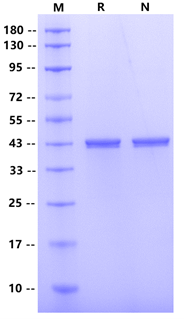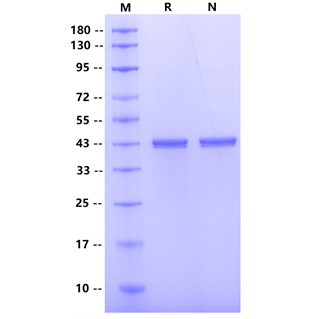Product Details
Product Details
Product Specification
| Species | HRSV |
| Synonyms | Nucleoprotein, Protein N, Nucleocapsid protein |
| Accession | P24566 |
| Amino Acid Sequence | Met1-Leu391, with N-terminal 8*His MHHHHHHHHMALSKVKLNDTLNKDQLLSSSKYTIQRSTGDNIDTPNYDVQKHLNKLCGMLLITEDANHKFTGLIGMLYAMSRLGREDTIKILKDAGYHVKANGVDITTYRQDINGKEMKFEVLTLSSLTSEIQVNIEIESRKSYKKLLKEMGEVAPEYRHDSPDCGMIILCIAALVITKLAAGDRSGLTAVIRRANNVLKNEIKRYKGLIPKDIANSFYEVFEKHPHLIDVFVHFGIAQSSTRGGSRVEGIFAGLFMNAYGSGQVMLRWGVLAKSVKNIMLGHASVQAEMEQVVEVYEYAQKLGGEAGFYHILNNPKASLLSLTQFPNFSSVVLGNAAGLGIMGEYRGTPRNQDLYDAAKAYAEQLKENGVINYSVLDLTAEELEAIKHQLNPKEDDVEL |
| Expression System | E.coli |
| Molecular Weight | 43kDa |
| Purity | >95% by SDS-PAGE |
| Endotoxin | <1EU/μg |
| Conjugation | Unconjugated |
| Tag | His Tag |
| Physical Appearance | Lyophilized Powder |
| Storage Buffer | 20mM PB, 150mM NaCl, 1mM EDTA, pH7.4 |
| Reconstitution | Reconstitute at 0.1-1 mg/ml according to the size in ultrapure water after rapid centrifugation. |
| Stability & Storage | · 12 months from date of receipt, lyophilized powder stored at -20 to -80℃. · 3 months, -20 to -80℃ under sterile conditions after reconstitution. · 1 week, 2 to 8℃ under sterile conditions after reconstitution. · Please avoid repeated freeze-thaw cycles. |
| Reference |
1、Oliveira A P. et al. (2013) Human respiratory syncytial virus N, P and M protein interactions in HEK-293T cells. Virus Res. 177(1): 108-112. 2、Céspedes P F. et al. (2014) Surface expression of the hRSV nucleoprotein impairs immunological synapse formation with T cells. Proc Natl Acad Sci U S A. 111(31): E3214. |
Background
Human Respiratory Syncytial Virus (HRSV) is a negative-sense single-stranded RNA virus that belongs to the Paramyxoviridae family and the Pneumovirinae subfamily, and considered the most important pathogen causing respiratory disease in infants and neonates worldwide. The nucleoprotein of HRSV, a canonical cytosolic protein, is highly conserved among pneumoviruses and interacts with viral RNA, generating a helicoidal nucleocapsid which is responsible for genome and anti-genome resistance to RNase. In addition, the nucleoprotein could be responsible for inhibiting T-cell activation during infection by HRSV, and expressed on the surface of epithelial and dendritic cells, preventing immunological synapse assembly by naïve CD4+ T cells. Therefore, this protein is defined as a major virulence factor that contributes to impairing acquired immunity and enhances susceptibility to reinfection by HRSV.
Picture
Picture
SDS-PAGE



